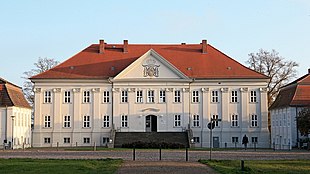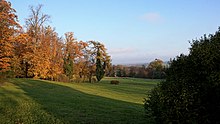Hohenzieritz Castle
The Hohenzieritz Castle is located in the town of Hohenzieritz in Mecklenburg-Vorpommern , about halfway between Neustrelitz and Neubrandenburg .
history
All that is known about a previous building of the castle is that it burned down in 1712. The tenant at the time, Hans Altwich von Holtzendorff , apparently only had a temporary replacement building built. In 1733 Johann Christian von Fabian was enfeoffed with Hohenzieritz. The castle was built on his behalf from 1747 to 1751, using parts of the previous building. The complex was built as a one-storey manor house in plastered half-timbering with a high basement and a high hipped roof . After the death of Hans Altwich's son Adam Friedrich von Fabian, Hohenzieritz fell back to the Strelitz dukes as a settled fief in 1768 , and in 1770 it went to the brother of the regent, later Grand Duke Karl II.
Shortly after the Neustrelitz doctor and mayor Johann Christian Wilhelm Verpoorten took possession of the complex, he had lofts expanded and a staircase to the garden laid out. In 1776, Verpoorten also added two single-storey pavilions with a pilaster facade and mansard roofs , which together with the main house surround a courtyard of honor. Around this time a gardener's house was built next to the southern pavilion and in the middle of the 19th century a stables was built next to the northern pavilion. In 1790/91 a second half-timbered storey was added to the castle, with the forest and surveying engineer Johann Christoph Dräsecke taking over the execution and largely having it restored to its current state. The interior was only expanded in 1795 by Wilhelm Ebel, who resorted to the braid and Empire style . In 1802 the building was given today's sandstone stairs on the courtyard and garden side, with the garden-side stairs being double-run and enclosing a vine arbor.
Hohenzieritz Castle, her father's summer residence, was always the main goal of the three family visits by Queen Luise of Prussia , a born Duchess of Mecklenburg from the Mecklenburg-Strelitz family . Luise died here on July 19, 1810. Her death room, redesigned as a memorial in 1813, rearranged in line with the taste of the late 19th century and restored in this style for several years, is now a memorial.
The palace remained in the possession of the ducal family until the November Revolution and in 1926 it was given to Prince Julius Ernst zur Lippe, brother-in-law of Strelitz Grand Duke Adolf Friedrich VI, who died in 1918, as part of the compensation for the prince. Parts of the palace, especially Queen Luise's death room and adjoining rooms, continued to be used as a museum. Among other things, a larger collection of children's toys from the legacies of the royal family was shown here. During the Second World War , Hohenzieritz Castle was a relocation site for art possessions from the Mecklenburg state collections, which resulted in major losses due to looting of the population.
The castle survived the end of the Second World War without major damage, although the interior fittings also disappeared. Owners and tenants were expropriated as part of the land reform in autumn 1945. Like many similar buildings, it initially served as refugee accommodation. Among other things, the windows of the Egyptian hall on the garden side were bricked up. In 1947 the castle was listed as a historical monument. From 1952, it was used as a sales point, cultural center, school, kindergarten and administration building in the GDR . From 1962 it housed the council of the local community and the scientific center for agriculture of the Neubrandenburg district. From 1950 to 1953 and from 1960 to 1963 the facility was renovated. The cellar was used from 1987 for the local youth club.
After German reunification, the castle was not used between 1992 and 2000 and was in danger of falling into disrepair.
In 1993 a support association was formed to preserve the castle. The extensive restoration and repair work began in 2000. Thereafter, Hohenzieritz Castle became the seat of the Müritz National Park administration. There is also a Queen Luise memorial in the palace. With the exception of the memorial, it cannot be visited; the park is freely accessible. The Hohenzieritz Castle Association was the operator of the memorial until the end of 2015. After the association was dissolved, the palace and gardens administration of the state of Mecklenburg-Western Pomerania also took over its sponsorship. After extensive redesign, the Queen Luise Memorial has presented itself since June 3, 2017 as a modern place of information and commemoration of the Prussian queen of Mecklenburg descent, on her last days in Hohenzieritz and the history of commemoration.
In addition to Hohenzieritz, the Villa Vier Jahreszeiten in Crimmitschau has one of the few permanent exhibitions on Luise (worship of Luise in the imperial era with an extensive library).
Building description
The entire complex opens up with a courtyard, upstream green areas and access to the north-west. Today, the castle is largely in the early Classicist form that it assumed at the end of the 18th century. The massive ground floor and the half-timbered upper floor are plastered, the base with imitation of plaster rustication highlighted. Ionic capitals made of carved oak characterize the facade. The high hipped roof is adorned with large triangular gables over risalits on the front and back as well as pilasters . In the triangular gable above the main entrance is the ducal coat of arms, on the back the Mecklenburg coat of arms is depicted, framed by cannon barrels and a crown.
The structure of the interiors still corresponds to the expansion by Wilhelm Ebel from 1795. The rooms are lined up as enfilades . In the basement, the garden hall dominates as the largest room, and on the upper floor the “Egyptian hall”, which measures the entire width of the building. Remnants of the original furnishings with lavishly designed wall and ceiling wallpapers have only survived in the “Chinese Hall”.
Castle Park
The castle park , which is now around 25 hectares in size , was laid out by Archibald Thompson, a student of Capability Brown , from 1776 to 1790 in the English style, taking the surrounding area into account. The overall composition extends over Hohenzieritz, Prillwitz, Usadel and Weisdin . On the garden side, the castle is on the top of a hill and offers a far-reaching view of the landscape. In the park is the Luise Temple and the monument, restored in 2006/2007, Hope Consoles Mourning , which Duke Charles II had his court architect and sculptor Christian Philipp Wolff erected in 1798 in memory of his wives and children who died young.
In 2008, extensive restoration work began in the Hohenzieritz Castle Park. The aim of the work was to restore the old park boundaries and entrances, to renovate the network of paths in the park and to restore the original terrain modeling. The state of Mecklenburg-Western Pomerania provided around 1.46 million euros for these measures. The first section was completed by the end of 2009. The historic park wall made of hewn field stones was reconstructed, a new parking lot was created, the castle square was renovated and an access road to the castle was built. The work was completed in 2011 with the renovation of the spring pond, the restoration of the waterfall and the Luisen garden and the renovation of the rose arbor. However, the overall impression is still impaired by unsuitable apartment blocks near the line of sight between the church and the castle.
Castle Church
At the beginning of the driveway is the church (former castle church). It was built in 1806 by Friedrich Wilhelm Dunckelberg . The church is a simple, classicist central building made of bricks with a Doric portal and a circumferential gallery inside. The dome shell, which is now white, was originally painted with cassettes . A gallery surrounds the church. The altar is in the west. In 1991 the church was rededicated after a renovation.
Duke Karl II had commissioned Caspar David Friedrich for a landscape altar. There is much to suggest that it is the 1808 Tetschen Altar with the painting The Cross in the Mountains , which the painter designed for the church of Hohenzieritz, even if the key work of Romanticism never saw the Mecklenburg chapel. The view from the castle park to the Lieps with the Schneckenberg is the motif of the romantic painter in the painting The Summer (Landscape with Lovers) from 1807.
literature
- Konrad Hustaedt: Hohenzieritz. Its art monuments and memorials . 2., rework. and greatly increased edition, Neustrelitz 1924.
- Christine Hinz: The Hohenzieritz park landscape. Neubrandenburg 1988.
- Sibylle Badstübner-Gröger: Hohenzieritz . [Series: Palaces and Gardens in Mecklenburg-Western Pomerania.] Deutsche Gesellschaft e. V., Berlin 1997.
- Marcus Köhler: Park, Hohenzieritz. In: White paper on historical gardens and parks in the new federal states. Edited by Bund Heimat und Umwelt in Germany. 2nd Edition. Bonn 2005, ISBN 3-925374-69-8 , pp. 82-84.
- Sabine Bock : Stately houses on the estates and domains in Mecklenburg-Strelitz. Architecture and history. (= Contributions to the history of architecture and the preservation of monuments. Volume 7.1–3). Thomas Helms Verlag , Schwerin 2008, ISBN 978-3-935749-05-3 , Volume 1, pp. 389-408.
- Friederike Drinkuth: Hohenzieritz Castle Park. Thomas Helms Verlag, Schwerin 2009, ISBN 978-3-940207-20-3 .
- Berit Ruge: Hohenzieritz Castle. In: Palaces and Gardens in Mecklenburg-Western Pomerania, Issue 13 (2nd, completely changed edition), Berlin 2010.
Web links
- Literature about Hohenzieritz Castle in the state bibliography MV
- Hohenzieritz Castle. - Further information from the Mecklenburg-Western Pomerania State Palace Administration
- Website of the "Luisen Memorial" Hohenzieritz
Individual evidence
- ^ Sabine Bock : Stately houses on the estates and domains in Mecklenburg-Strelitz. Architecture and history. (= Contributions to the history of architecture and the preservation of monuments. Volume 7.1–3). Thomas Helms Verlag , Schwerin 2008, ISBN 978-3-935749-05-3 , Volume 1, p. 400.
- ^ Sabine Bock : Stately houses on the estates and domains in Mecklenburg-Strelitz. Architecture and history. (= Contributions to the history of architecture and the preservation of monuments. Volume 7.1–3). Thomas Helms Verlag , Schwerin 2008, ISBN 978-3-935749-05-3 , Volume 1, p. 390.
- ↑ Nothing is known about the whereabouts of this collection.
- ↑ See: Documentation of the missing works of art from the Mecklenburgisches Landesmuseum in Schwerin. 4 volumes (1998-2005).
- ^ Sabine Bock : Stately houses on the estates and domains in Mecklenburg-Strelitz. Architecture and history. (= Contributions to the history of architecture and the preservation of monuments. Volume 7.1–3). Thomas Helms Verlag , Schwerin 2008, ISBN 978-3-935749-05-3 , Volume 1, p. 390.
- ↑ Land takes over the Louisen Memorial in Hohenzieritz. welt.de, November 27, 2015, accessed on November 27, 2015 .
- ↑ The museum educator Mara Maroske, who was hired by the state in 2016, was dismissed at the beginning of 2018; the position will initially remain vacant. - See Luisengedenkstätte Hohenzieritz no longer has a museum educator , Nordkurier , February 1, 2018
- ↑ Start of construction at Rostock University Medical Center ( Memento from July 22, 2012 in the web archive archive.today ) Press release from the Mecklenburg-Western Pomerania company for construction and real estate, August 4, 2008.
- ↑ Hohenzieritz palace gardens restored ( memento from February 10, 2013 in the web archive archive.today ) July 29, 2011, operation for construction and real estate Mecklenburg-Western Pomerania
- ^ Kurt Karl Eberlein: Friedrich the landscape painter. In: Genius II, 1st book, 1939, p. 39
- ↑ Detlef Stapf: Caspar David Friedrichs hidden landscapes. The Neubrandenburg contexts . Greifswald 2014, network-based P-Book
Coordinates: 53 ° 26 ′ 38 ″ N , 13 ° 6 ′ 8 ″ E






